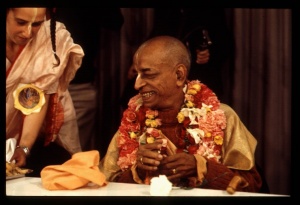CC Adi 13.118 (1975): Difference between revisions
(Vanibot #0027: CCMirror - Mirror CC's 1996 edition to form a basis for 1975) |
(Vanibot #0020: VersionCompareLinker - added a link to the Version Compare feature) |
||
| Line 2: | Line 2: | ||
<div style="float:left">'''[[Sri Caitanya-caritamrta (1975)|Śrī Caitanya-caritāmṛta (1975)]] - [[CC Adi (1975)|Ādi-līlā]] - [[CC Adi 13 (1975)|Chapter 13: The Advent of Lord Śrī Caitanya Mahāprabhu]]'''</div> | <div style="float:left">'''[[Sri Caitanya-caritamrta (1975)|Śrī Caitanya-caritāmṛta (1975)]] - [[CC Adi (1975)|Ādi-līlā]] - [[CC Adi 13 (1975)|Chapter 13: The Advent of Lord Śrī Caitanya Mahāprabhu]]'''</div> | ||
<div style="float:right">[[File:Go-previous.png|link=CC Adi 13.117 (1975)|Ādi-līlā 13.117]] '''[[CC Adi 13.117 (1975)|Ādi-līlā 13.117]] - [[CC Adi 13.119 (1975)|Ādi-līlā 13.119]]''' [[File:Go-next.png|link=CC Adi 13.119 (1975)|Ādi-līlā 13.119]]</div> | <div style="float:right">[[File:Go-previous.png|link=CC Adi 13.117 (1975)|Ādi-līlā 13.117]] '''[[CC Adi 13.117 (1975)|Ādi-līlā 13.117]] - [[CC Adi 13.119 (1975)|Ādi-līlā 13.119]]''' [[File:Go-next.png|link=CC Adi 13.119 (1975)|Ādi-līlā 13.119]]</div> | ||
{{CompareVersions|CC|Adi 13.118|CC 1975|CC 1996}} | |||
{{RandomImage}} | {{RandomImage}} | ||
==== TEXT 118 ==== | ==== TEXT 118 ==== | ||
| Line 11: | Line 10: | ||
<div class="verse"> | <div class="verse"> | ||
:putramātā-snānadine, dila vastra vibhūṣaṇe, | :putramātā-snānadine, dila vastra vibhūṣaṇe, | ||
:putra-saha miśrere | :putra-saha miśrere sammāni' | ||
:śacī-miśrera pūjā lañā, manete hariṣa hañā, | :śacī-miśrera pūjā lañā, manete hariṣa hañā, | ||
:ghare āilā sītā ṭhākurāṇī | :ghare āilā sītā ṭhākurāṇī | ||
| Line 20: | Line 19: | ||
<div class="synonyms"> | <div class="synonyms"> | ||
putra-mātā—of the mother and child; snāna-dine—on the day of bathing; dila—gave; vastra—cloth; vibhūṣaṇe—ornaments; putra-saha—with the child; miśrere—unto Jagannātha Miśra; | putra-mātā—of the mother and child; snāna-dine—on the day of bathing; dila—gave; vastra—cloth; vibhūṣaṇe—ornaments; putra-saha—with the child; miśrere—unto Jagannātha Miśra; sammāni'-congratulating; śacī—Śacīdevī; miśrera—Jagannātha Miśra; pūjā—honor; lañā—receiving; manete—within the mind; hariṣa—pleased; hañā—becoming; ghare—home; āilā—returned; sītā ṭhākurāṇī—mother Sītā, wife of Advaita Ācārya. | ||
</div> | </div> | ||
| Line 34: | Line 33: | ||
<div class="purport"> | <div class="purport"> | ||
On the fifth day from the birth of a child, as also on the ninth day, the mother bathes either in the Ganges or in | On the fifth day from the birth of a child, as also on the ninth day, the mother bathes either in the Ganges or in a sacred place. This is called niṣkrāmaṇa, or the ceremony of coming out of the maternity home. Nowadays the maternity home is a hospital, but formerly in every respectable house one room was set aside as a maternity home where children would take birth, and on the ninth day after the birth of a child the mother would come into the regular rooms in the ceremony called niṣkrāmaṇa. Of the ten purificatory processes, niṣkrāmaṇa is one. Formerly, especially in Bengal, the higher castes observed four months after the birth of a child as a quarantine. At the end of the fourth month, the mother first had to see the sun rise. Later the higher castes, namely, the brāhmaṇas, kṣatriyas and vaiśyas, observed only twenty-one days as a quarantine, whereas the śūdras had to observe thirty days. For the sections of society known as kartābhajā and satīmā, the mother of the child was immediately purified after the quarantine by the throwing of hari-nuṭa, small pieces of sweetmeat, in saṅkīrtana. Śacīdevī and Jagannātha Miśra, with the newly born child, were honored by Sītā Ṭhākurāṇī. Similarly, while Sītā Ṭhākurāṇī was returning home, she was also honored by Śacīdevī and Jagannātha Miśra. That was the system in respectable families of Bengal. | ||
</div> | </div> | ||
Latest revision as of 14:58, 26 January 2020

A.C. Bhaktivedanta Swami Prabhupada
TEXT 118
- putramātā-snānadine, dila vastra vibhūṣaṇe,
- putra-saha miśrere sammāni'
- śacī-miśrera pūjā lañā, manete hariṣa hañā,
- ghare āilā sītā ṭhākurāṇī
SYNONYMS
putra-mātā—of the mother and child; snāna-dine—on the day of bathing; dila—gave; vastra—cloth; vibhūṣaṇe—ornaments; putra-saha—with the child; miśrere—unto Jagannātha Miśra; sammāni'-congratulating; śacī—Śacīdevī; miśrera—Jagannātha Miśra; pūjā—honor; lañā—receiving; manete—within the mind; hariṣa—pleased; hañā—becoming; ghare—home; āilā—returned; sītā ṭhākurāṇī—mother Sītā, wife of Advaita Ācārya.
TRANSLATION
On the day the mother and son bathed and left the maternity home, Sītā Ṭhākurāṇī gave them all kinds of ornaments and garments and then also honored Jagannātha Miśra. Then Sītā Ṭhākurāṇī, being honored by mother Śacīdevī and Jagannātha Miśra, was greatly happy within her mind, and thus she returned home.
PURPORT
On the fifth day from the birth of a child, as also on the ninth day, the mother bathes either in the Ganges or in a sacred place. This is called niṣkrāmaṇa, or the ceremony of coming out of the maternity home. Nowadays the maternity home is a hospital, but formerly in every respectable house one room was set aside as a maternity home where children would take birth, and on the ninth day after the birth of a child the mother would come into the regular rooms in the ceremony called niṣkrāmaṇa. Of the ten purificatory processes, niṣkrāmaṇa is one. Formerly, especially in Bengal, the higher castes observed four months after the birth of a child as a quarantine. At the end of the fourth month, the mother first had to see the sun rise. Later the higher castes, namely, the brāhmaṇas, kṣatriyas and vaiśyas, observed only twenty-one days as a quarantine, whereas the śūdras had to observe thirty days. For the sections of society known as kartābhajā and satīmā, the mother of the child was immediately purified after the quarantine by the throwing of hari-nuṭa, small pieces of sweetmeat, in saṅkīrtana. Śacīdevī and Jagannātha Miśra, with the newly born child, were honored by Sītā Ṭhākurāṇī. Similarly, while Sītā Ṭhākurāṇī was returning home, she was also honored by Śacīdevī and Jagannātha Miśra. That was the system in respectable families of Bengal.